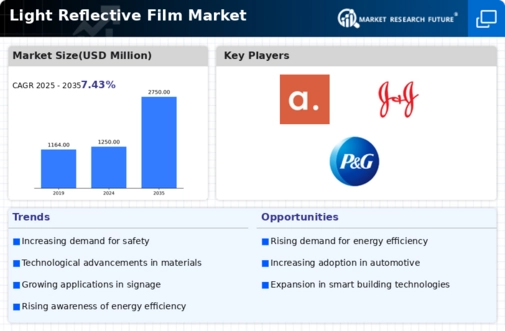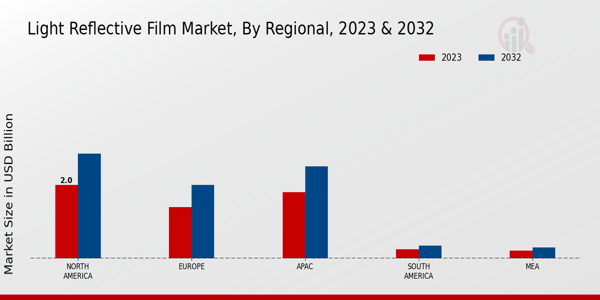Market Growth Projections
The Global Light Reflective Film Market Industry is poised for substantial growth, with projections indicating a market value of 1250 USD Million in 2024 and an anticipated increase to 2750 USD Million by 2035. This growth trajectory suggests a compound annual growth rate of 7.43% from 2025 to 2035, driven by various factors including technological advancements, urbanization, and increasing safety regulations. The market's expansion reflects a growing recognition of the importance of reflective materials in enhancing visibility and safety across multiple applications. As industries continue to adopt these solutions, the market is likely to evolve, adapting to emerging trends and consumer needs.
Rising Awareness of Energy Efficiency
The Global Light Reflective Film Market Industry benefits from the growing awareness of energy efficiency and sustainability. Reflective films are increasingly employed in building applications to reduce heat absorption, thereby lowering energy consumption for cooling systems. This trend aligns with global efforts to combat climate change and promote sustainable practices. For example, reflective films can be applied to windows and facades to improve energy efficiency in commercial buildings. As the market evolves, the integration of energy-efficient solutions is likely to drive further adoption, contributing to the projected market growth to 2750 USD Million by 2035.
Diverse Applications Across Industries
The versatility of light reflective films across various industries serves as a significant driver for the Global Light Reflective Film Market Industry. These films find applications in sectors such as automotive, construction, safety apparel, and advertising. For instance, reflective films are used in safety gear for workers in low-light environments, enhancing visibility and reducing accidents. This broad applicability ensures a steady demand across different market segments. As the market matures, the diverse applications are expected to sustain growth, with a forecasted increase to 1250 USD Million in 2024, reflecting the films' essential role in enhancing safety and visibility.
Growing Demand for Safety and Visibility
The Global Light Reflective Film Market Industry experiences a surge in demand driven by the increasing emphasis on safety and visibility in various applications. This trend is particularly evident in the automotive sector, where reflective films enhance the visibility of vehicles during low-light conditions. For instance, regulations in several countries mandate the use of reflective materials on emergency vehicles, contributing to market growth. As of 2024, the market is valued at approximately 1250 USD Million, indicating a robust interest in products that improve safety standards and reduce accidents. This heightened focus on safety is likely to propel the market further.
Technological Advancements in Film Production
Technological innovations in the production of light reflective films significantly influence the Global Light Reflective Film Market Industry. Advanced manufacturing techniques, such as the use of nanotechnology and improved polymer formulations, enhance the performance and durability of reflective films. These advancements not only improve the reflective properties but also reduce production costs, making these films more accessible to various industries. As a result, the market is expected to expand, with projections indicating a growth to 2750 USD Million by 2035. The continuous evolution of production technologies appears to be a key driver in meeting the diverse needs of consumers.
Increasing Urbanization and Infrastructure Development
The Global Light Reflective Film Market Industry is positively impacted by the rapid urbanization and infrastructure development occurring worldwide. As cities expand, the need for effective traffic management and safety measures becomes paramount. Reflective films are increasingly utilized in road signage, lane markings, and pedestrian crossings to enhance visibility and safety. This trend is particularly pronounced in developing regions, where infrastructure projects are on the rise. The anticipated compound annual growth rate of 7.43% from 2025 to 2035 suggests that the market will continue to thrive as urban areas prioritize safety and efficiency in their designs.





